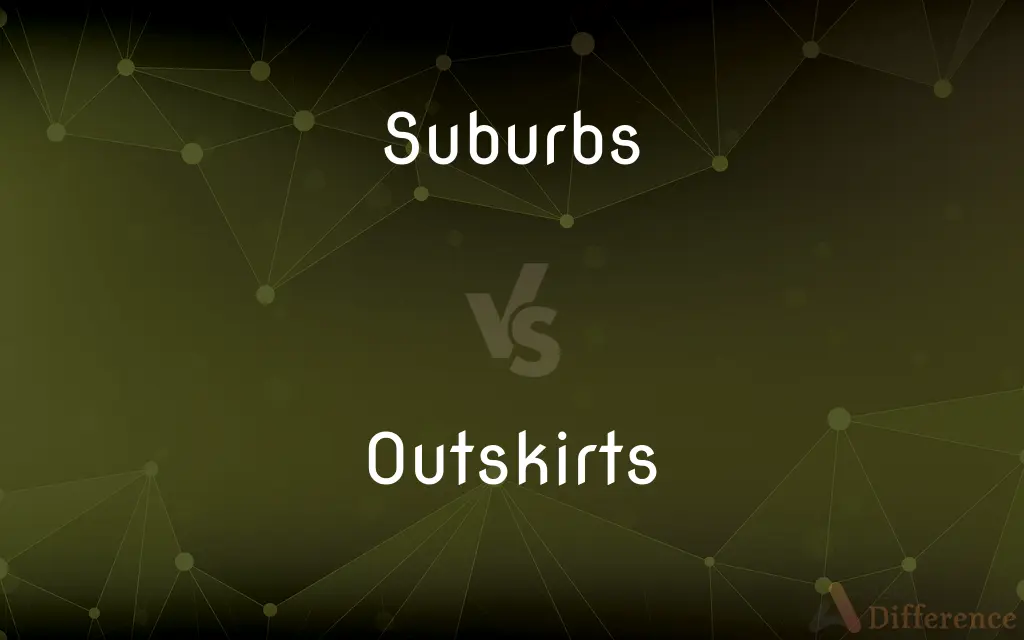Suburbs vs. Outskirts — What's the Difference?
By Urooj Arif & Maham Liaqat — Updated on March 19, 2024
Suburbs are residential areas on the edge of cities, offering a blend of urban and rural qualities, while outskirts refer to the outer areas of a city, often less developed and more rural.

Difference Between Suburbs and Outskirts
Table of Contents
ADVERTISEMENT
Key Differences
Suburbs are defined residential zones located on the periphery of urban areas. They are characterized by their mix of residential properties, commercial areas, and public spaces, providing a balanced living environment with access to urban amenities while maintaining a quieter, more spacious setting. On the other hand, outskirts represent the outermost parts of a city or town, marking the transition between urban development and rural landscapes. The outskirts can include a mix of sparse residential areas, industrial sites, and undeveloped land.
While suburbs are often well-planned and integrated into the urban ecosystem with deliberate infrastructural and community development, outskirts can be more haphazard in their growth, sometimes resulting from gradual urban sprawl rather than intentional urban planning. Suburbs are sought after for their blend of urban convenience and peaceful living, whereas outskirts might appeal to those looking for more space, privacy, or proximity to natural surroundings, albeit with potentially less access to urban conveniences.
The distinction between suburbs and outskirts can vary by region and city size. In larger metropolitan areas, the suburbs can be quite expansive and may themselves encompass areas that could be considered as outskirts in smaller cities or towns.
Accessibility to the city center is another key difference. Suburbs are typically well-connected to the urban core through major roads, public transit systems, and bike paths, facilitating commutes and access to city amenities. Outskirts, by their nature, are further removed from the city center and might have less developed transportation infrastructure, making them more isolated but possibly more peaceful and closer to rural areas.
Comparison Chart
Location
Edge of cities, well-integrated into urban areas
Outermost parts of a city, transitional zones
ADVERTISEMENT
Development
Well-planned residential and commercial areas
Mix of sparse development and undeveloped land
Population
Moderately dense, family-oriented
Less dense, varied demographics
Amenities
Full range of services, schools, parks
Fewer amenities, more space and privacy
Connectivity
Good transport links to city center
Less connectivity, more isolated
Compare with Definitions
Suburbs
Residential areas on the outskirts of a city with a mix of housing, commerce, and public spaces.
The family moved to the suburbs for a larger home and better schools.
Outskirts
The outer areas of a city, marking the transition from urban to rural.
The factory is located on the outskirts, where the city meets the countryside.
Suburbs
Characterized by moderate density and family-oriented communities.
Suburban neighborhoods often have community events and associations.
Outskirts
Often less developed and more sparsely populated.
The outskirts are dotted with farms and undeveloped land, with few houses in between.
Suburbs
Offers a blend of urban amenities and a quieter lifestyle.
Living in the suburbs offers the convenience of nearby shops with the tranquility of less traffic.
Outskirts
Less connectivity and access to urban amenities.
Residents on the outskirts often have to travel to the city for shopping and services.
Suburbs
Planned development with a focus on residential living.
The city's expansion plan includes developing new suburbs with ample green spaces.
Outskirts
Can include industrial sites and undeveloped areas.
The new distribution center is being built on the outskirts to minimize traffic in the city.
Suburbs
Well-connected to urban centers, facilitating commutes.
The new subway line made commuting from the suburbs much easier.
Outskirts
Appeals for its space, privacy, and proximity to nature.
Artists seeking solitude for their work find the outskirts ideal for their studios.
Suburbs
A usually residential area or community outlying a city.
Outskirts
The part or region remote from a central district, as of a city or town
The outskirts of Buenos Aires.
Suburbs
Suburbs The usually residential region around a major city; the environs.
Outskirts
The area surrounding a city or town; suburb.
He lived on the outskirts of Paris for a time.
Suburbs
Plural of suburb
Outskirts
Outlying areas (as of a city or town);
They lived on the outskirts of Houston
They mingled in the outskirts of the crowd
Suburbs
The populated area surrounding a city.
Common Curiosities
Can outskirts become suburbs over time?
Yes, as cities expand and develop, areas once considered outskirts can be incorporated into the urban fabric as suburbs through planning and development.
What are the outskirts of a city?
The outskirts are the outermost areas of a city, often less developed, marking the transition between urban development and rural landscapes.
Are suburbs considered part of the city?
Suburbs are generally considered part of the metropolitan area of a city, but they maintain distinct administrative and community identities.
What defines a suburb?
A suburb is a residential area located on the edge of a city, characterized by a mix of housing, commercial spaces, and public amenities, offering a balance between urban and rural living.
How does transportation differ between suburbs and outskirts?
Suburbs often have well-developed transportation links to the city, including roads and public transit, while outskirts may have less infrastructure, making them more isolated.
Why do people choose to live in the suburbs?
People often choose the suburbs for more affordable housing, larger living spaces, better schools, and a more family-friendly environment.
Do outskirts always lack amenities and services?
While outskirts might have fewer amenities compared to suburbs and urban centers, they can still offer essential services, depending on their development.
How do suburbs differ from urban areas?
Suburbs offer more space, lower density, and a quieter environment compared to the bustling, compact nature of urban centers.
Are suburbs more expensive than living in the city?
It can vary widely; suburbs might offer more affordable housing options than the city center, but this depends on the city, the suburb's proximity, and its amenities.
How do cities plan for suburban development?
City planners consider factors like housing needs, transportation infrastructure, commercial development, and public amenities to create balanced and sustainable suburban communities.
What impact does living in the outskirts have on lifestyle?
Living in the outskirts can offer a quieter, more rural lifestyle with greater privacy and access to nature, but it may also require longer commutes and less access to urban conveniences.
How do environmental considerations impact suburban and outskirts development?
Environmental considerations can shape the development of both, with efforts to preserve green spaces, manage traffic, and ensure sustainable growth.
Can living in the suburbs or outskirts affect community involvement?
Both can foster strong communities, but the nature of involvement might differ, with suburbs often having more structured community organizations and activities.
What role do economic factors play in the growth of suburbs and outskirts?
Economic factors, including housing affordability, job locations, and transportation costs, significantly influence the development and expansion of suburbs and outskirts.
Share Your Discovery

Previous Comparison
Animation vs. Video
Next Comparison
Ferromagnetism vs. FerrimagnetismAuthor Spotlight
Written by
Urooj ArifUrooj is a skilled content writer at Ask Difference, known for her exceptional ability to simplify complex topics into engaging and informative content. With a passion for research and a flair for clear, concise writing, she consistently delivers articles that resonate with our diverse audience.
Co-written by
Maham Liaqat















































